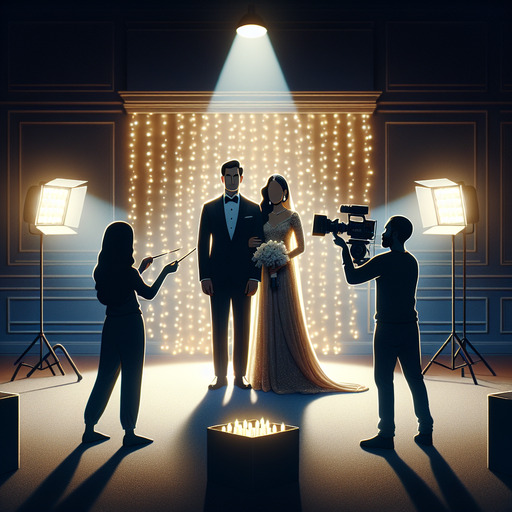
-
Table of Contents
Discover the secrets to perfect wedding videography lighting and capture unforgettable moments! Learn more here.
Introduction
Wedding videography lighting is a crucial element in capturing the magic and emotion of a couple’s special day. Proper lighting can transform ordinary footage into cinematic masterpieces, highlighting the intricate details of the venue, the expressions of the guests, and the intimate moments shared between the bride and groom. To achieve the best shots, videographers must understand the principles of lighting, including natural light, artificial light, and the strategic use of shadows and highlights. This guide delves into the essential techniques and tools needed to master wedding videography lighting, ensuring that every cherished moment is beautifully illuminated and preserved for a lifetime.
Mastering Wedding Videography Lighting: Tips for Capturing Cinematic Shots
Capturing the magic of a wedding day through videography requires a keen eye for detail, a deep understanding of the couple’s vision, and, crucially, mastery over lighting. Lighting can make or break a wedding video, transforming ordinary moments into cinematic masterpieces or, conversely, rendering them flat and uninspiring. To achieve the best shots, it is essential to understand the nuances of wedding videography lighting and how to manipulate it effectively.
First and foremost, natural light is a videographer’s best friend. The soft, diffused light of early morning or late afternoon, often referred to as the “golden hour,” provides a warm, flattering glow that enhances the romantic atmosphere of a wedding. When shooting outdoors, positioning the couple with the sun behind them can create a beautiful backlit effect, adding depth and dimension to the footage. However, it is crucial to avoid harsh midday sunlight, which can cast unflattering shadows and cause subjects to squint. In such cases, seeking shade or using a diffuser can help soften the light and create a more pleasing visual.
Transitioning to indoor settings, the challenge often lies in dealing with artificial lighting. Wedding venues can vary significantly in their lighting conditions, from dimly lit churches to brightly illuminated reception halls. To adapt, videographers should be equipped with a range of lighting tools, such as LED panels, softboxes, and on-camera lights. These tools allow for greater control over the lighting environment, ensuring that the couple and their guests are well-lit without being overexposed. Additionally, using color-correcting gels can help balance the color temperature of different light sources, maintaining a consistent and natural look throughout the video.
Moreover, understanding the interplay between light and shadow is crucial for creating dynamic and visually engaging shots. Shadows can add a sense of drama and depth, but they must be used judiciously. For instance, during the ceremony, positioning lights to highlight the couple while allowing the background to fall into softer shadows can draw the viewer’s attention to the emotional core of the event. Similarly, during the reception, using uplighting to accentuate architectural features or create a vibrant dance floor atmosphere can enhance the overall visual appeal of the video.
In addition to technical considerations, communication with the couple and other vendors is vital. Discussing the wedding schedule and lighting conditions in advance allows for better planning and coordination. For example, if the couple desires a sunset shot, knowing the exact time of sunset and scouting the location beforehand ensures that the moment is captured perfectly. Collaborating with the photographer, who often shares similar lighting concerns, can also lead to more cohesive and complementary visual storytelling.
Furthermore, post-production plays a significant role in refining the final product. Color grading can enhance the mood and tone of the footage, while careful editing can ensure that the lighting remains consistent across different scenes. Investing time in learning advanced editing techniques and software can elevate the quality of the wedding video, making it a cherished keepsake for the couple.
In conclusion, mastering wedding videography lighting involves a combination of technical skill, creative vision, and effective communication. By harnessing the power of natural light, adapting to various indoor lighting conditions, and understanding the role of shadows, videographers can capture the essence of a wedding day in all its cinematic glory. With careful planning and attention to detail, the resulting video will not only document the event but also evoke the emotions and memories that make weddings so special.
Q&A
1. **Question:** What are some essential tips for achieving optimal lighting in wedding videography?
**Answer:**
– Use natural light whenever possible, especially during outdoor ceremonies.
– Employ diffused lighting to soften harsh shadows and create a flattering look.
– Utilize LED panels or softboxes for consistent and adjustable lighting indoors.
– Position lights at a 45-degree angle to the subject to create depth and dimension.
– Consider using backlighting to add a romantic glow and highlight the couple.
– Adjust white balance settings to match the lighting conditions and ensure accurate color representation.
– Scout the venue beforehand to identify the best lighting opportunities and potential challenges.
– Use reflectors to bounce light and fill in shadows on the subjects’ faces.
– Be prepared with portable lighting solutions for dynamic and changing environments.
– Coordinate with the wedding photographer to ensure cohesive lighting setups.